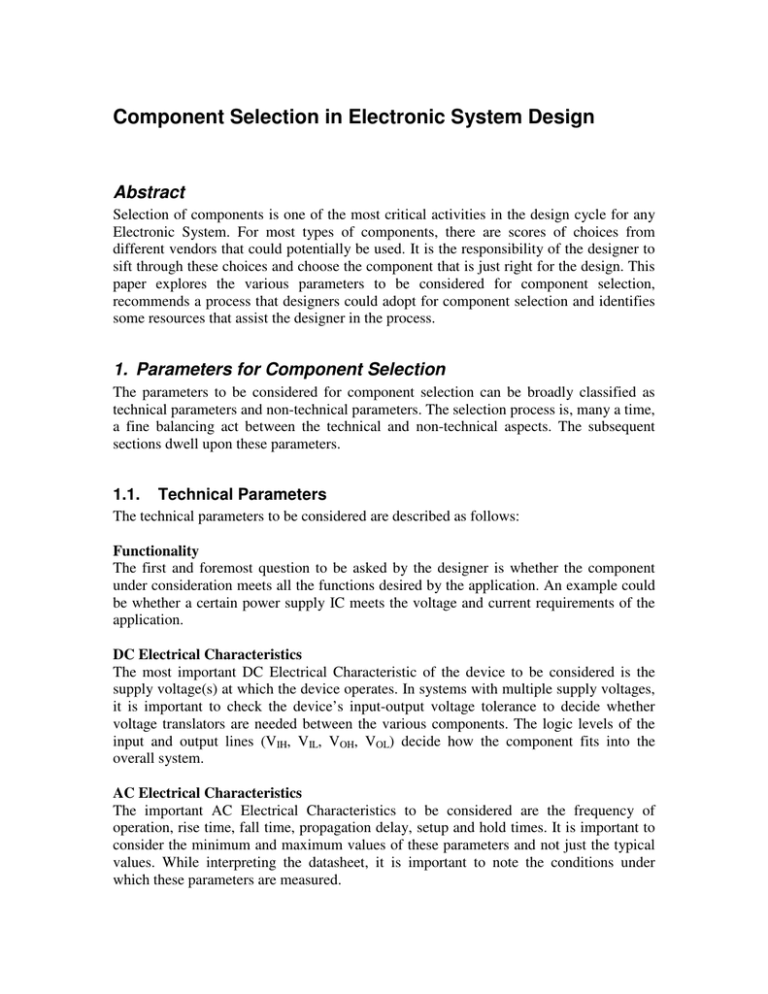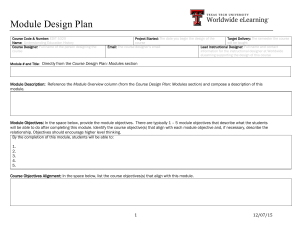Component Selection in Electronic System Design
advertisement

Component Selection in Electronic System Design Abstract Selection of components is one of the most critical activities in the design cycle for any Electronic System. For most types of components, there are scores of choices from different vendors that could potentially be used. It is the responsibility of the designer to sift through these choices and choose the component that is just right for the design. This paper explores the various parameters to be considered for component selection, recommends a process that designers could adopt for component selection and identifies some resources that assist the designer in the process. 1. Parameters for Component Selection The parameters to be considered for component selection can be broadly classified as technical parameters and non-technical parameters. The selection process is, many a time, a fine balancing act between the technical and non-technical aspects. The subsequent sections dwell upon these parameters. 1.1. Technical Parameters The technical parameters to be considered are described as follows: Functionality The first and foremost question to be asked by the designer is whether the component under consideration meets all the functions desired by the application. An example could be whether a certain power supply IC meets the voltage and current requirements of the application. DC Electrical Characteristics The most important DC Electrical Characteristic of the device to be considered is the supply voltage(s) at which the device operates. In systems with multiple supply voltages, it is important to check the device’s input-output voltage tolerance to decide whether voltage translators are needed between the various components. The logic levels of the input and output lines (VIH, VIL, VOH, VOL) decide how the component fits into the overall system. AC Electrical Characteristics The important AC Electrical Characteristics to be considered are the frequency of operation, rise time, fall time, propagation delay, setup and hold times. It is important to consider the minimum and maximum values of these parameters and not just the typical values. While interpreting the datasheet, it is important to note the conditions under which these parameters are measured. Power Consumption The general guideline for this parameter is that it should be as low as possible. This becomes the decisive factor in choosing components for portable, battery operated systems. The designer could look at special features such as availability of sleep modes, idle modes etc that enable to reduce the power consumption when the device is not active. For example, in a portable audio player, it would be ideal to choose a codec chip that not only has lower active power, but also supports switching to a low power mode when not playing back music. Supporting Circuit Elements While choosing a component, it is essential to consider the additional circuitry that allows the component to operate. With the levels of integration going ever higher, it would be better to choose components that support greater on-chip features so that the number of external components is reduced. Greater the on-chip features, lesser the cost, physical size and power consumption of the system. For example, when choosing a processor IC, the designer could look for the set of peripherals supported such as DMA Controllers, onchip memory etc also in additional to the core processor function. When choosing Switched Mode Power Supply (SMPS) IC, the designer could look for ICs with built-in MOSFET. Another important factor to be considered is the number and type of power supplies required for the operation of the IC. For example, when choosing an Analog to Digital Converter (ADC), it would be essential to consider the Power Supply Rejection Ratio (PSRR) to decide on the ripple specification of the power supply that drives the ADC. Operating Environment requirements Every component is specified to operate in a certain temperature and relative humidity range. Based on this criterion, components are classified as belonging to the Commercial grade, Industrial grade and the Military grade. The designer could choose the appropriate grade component based on the system’s operating environment. Regulatory Requirements Regulatory requirements of different national regulatory bodies place constraints on the choice of components. An example for this is the Restriction on the use of certain Hazardous Substances (RoHS) directive of the European Union. This directive bars the usage of Lead (Pb) and other hazardous substances in electronic systems. Support for Pbfree soldering and compliance to RoHS directive could be an important criterion for choosing a certain component. Another example is to verify whether a module or subassembly like AC-DC Converter, being considered is certified to meet FCC, CE or UL requirements. Reliability Data Comparison of component reliability parameters such as the Mean Time Between Failure (MTBF) of different components being considered would be essential for design of high reliability systems. While the MTBF data is not generally available from a component datasheet, this could be obtained from the manufacturer. IP Availability When the component under consideration is a Processor or a Programmable Logic Device such as CPLD or FPGA, availability of Intellectual Property (IP) that can be licensed from the IC vendor or third parties is a critical choice that enables faster time-tomarket. For example, availability of different operating systems on a processor, availability of audio or video codec software IP on a Digital Signal Processor etc., enable the system to hit the market faster. Development Tools Availability and quality of development tools is a very critical parameter for certain types of components such as Microprocessors, Microcontrollers, Programmable Logic devices etc. Scope for enhancement Scope for future enhancement is an important factor since all requirements may not be clear enough upfront in the design phase. For example, choose memory packages that support larger capacity in the same footprint. Similarly, choose programmable logic devices that support larger number of logic gates in the same footprint. Physical Size The physical size of a component is another critical parameter for system design especially in the case of hand held and portable systems. 1.2. Non-Technical Parameters Cost Cost is a critical constraint in any component selection. The important point to be seen is the cost of the total solution than just the cost of the particular component under consideration. Multiple Sources For mass production, having multiple suppliers and manufacturers for the component is a desirable feature since it eases procurement and lowers cost due to competition. Also, the risk of component obsolescence is reduced. A good guideline to follow for selection of components like buffers, logic gates, operational amplifiers etc., is to choose those packages that are made by multiple vendors. Stage of Production It is essential to consider the stage of production the component being considered is in. For example, the component could be in the Engineering Sample phase, Active Production phase, Not-for-Future-Design (NFD) phase or Obsolete phase. The components in the NFD phase and Obsolete phase should not be designed in. For components in Engineering Sample phase, it is essential to verify if the production schedule of the component matches with that of the product being designed. Legacy Components used in previous versions of the system are good candidates for a new version of the system. This permits reuse of device drivers, software, schematics, layout and knowledge, thereby reducing the risk. While reusing legacy components, it is important to verify whether the component is still in active production and also if there are any known issues with the component. 2. Process for selection Now that we have seen the parameters for component selection, let us look at a good process for the selection. The first step is to understand and prioritize the requirements. Classify the features as must-have and nice-to-have. This is followed by research to find the candidate components and detailed study of their datasheets. Some good resources for this research are internet search, literature search, IC vendor websites, competitor products, teardown reports and reviews. Once the candidate components are shortlisted, tabulate all the features of the candidate parts and review this with the concerned teams. The review is important since system design has many stake holders such as the software developers, marketing teams and customers. If necessary, a more thorough evaluation can be done using evaluation boards from the IC vendor. The next step is to identify suppliers and sources for the component. A few points to remember in the selection process are summarized below. It is essential for the designer not to go by Sheet 1 of the datasheet, as many a time, this sheet highlights only the best aspects of the component. For each performance claim, note the conditions under which the performance is measured and verify if these conditions match the operating conditions of the system under design. The figures and graphs in a datasheet convey a lot of factual information, hence pay a lot of attention to these. Research for component selection is a continuous process and it is essential for the designer to track the developments in her area of specialization. The designer should watch out for new component announcements and obsolescence notices from IC vendor websites, newsletters etc. Independent reviews are also a good source of information. The study and research are best done well before the actual design cycle begins so as to cut down on the design time without compromising the selection process. 3. Resources In this section we examine a few resources that come in handy for component selection. Journals such as Electronic Component News (ECN) provide a wealth of information for the system designer about a wide variety of components. Websites such as www.electropages.com provide periodic updates on the latest component announcements from different vendors. Mailing lists of users of certain components are also a good source of information. Designers can subscribe to newsletters from IC vendors’ websites. Sites such as www.tomshardwareguide.com provide detailed reviews while sites like www.teardown.com provide teardown reports of competitor components. 4. Conclusion In conclusion, we can see that component selection is a function of large number of technical and non-technical parameters. Continuous and meticulous study by the designer is critical to good component selection. About the Author Satheesh Sadanand, Principal Engineer, Ittiam Systems Pvt Ltd, holds a Masters Degree from the Indian Institute of Science. He has 10 years of experience in Hardware and System design in the fields of Telecommunication and Multimedia. His expertise is in DSP based systems such as Portable Media Players, Network Media Players, GSM transcoders etc. Prior to joining Ittiam Systems, he worked with the Centre for Development of Telematics for over 6 years.



